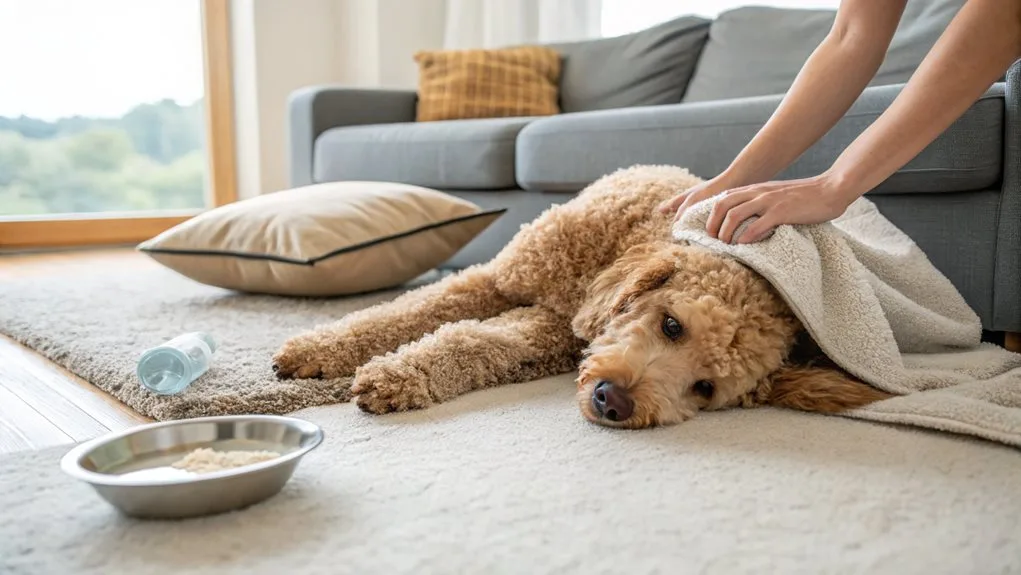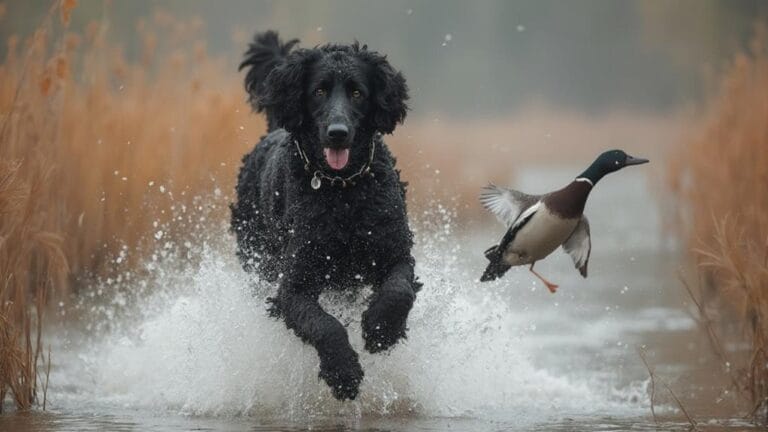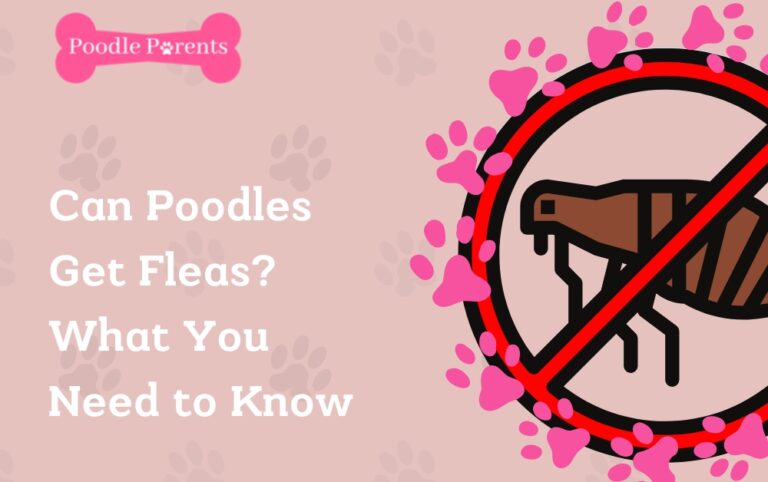What You Need to Know About Bloat in Poodles

Bloat, or Gastric Dilatation-Volvulus (GDV), is a severe condition in Poodles where the stomach fills with gas and potentially twists, requiring immediate emergency care. Standard Poodles are especially at risk due to their deep chests and narrow frames.
Key warning signs include a swollen abdomen, unsuccessful attempts to vomit, excessive drooling, and visible distress. Prevention strategies include feeding smaller meals throughout the day, using slow-feeder bowls, and avoiding exercise around mealtimes.
Genetic testing can help identify at-risk dogs, while proper feeding habits and regular vet check-ups are essential safeguards. Understanding these fundamentals is just the starting point for keeping your Poodle safe and healthy.
Key Takeaways
- Bloat is a life-threatening emergency where a poodle’s stomach fills with gas and twists, requiring immediate veterinary care.
- Standard Poodles are especially prone to bloat due to their deep chest cavity and narrow frame.
- Key symptoms include a swollen abdomen, unsuccessful attempts to vomit, excessive drooling, and visible distress or pacing.
- Feed smaller meals throughout the day and avoid exercise for at least one hour after meals to reduce risk.
- Dogs over four years old have increased risk, especially if they eat quickly or have relatives who experienced bloat.
What Is Bloat

Bloat, also known as Gastric Dilatation-Volvulus (GDV), is a life-threatening condition that occurs when a dog’s stomach fills with gas and twists upon itself. This dangerous condition can develop rapidly, often within hours, making it essential for Poodle owners to recognize its signs early.
The anatomical causes of bloat in Poodles are closely linked to their breed history and physical structure. Poodles, particularly Standard Poodles, have deep chests and narrow waists – a body type that unfortunately makes them more susceptible to this condition.
Think of their chest cavity like a hammock that allows the stomach to swing more freely than in other breeds. With their muscular build and power, Poodles’ physical features contribute to both their athletic abilities and their susceptibility to this condition.
When bloat occurs, the stomach expands with gas like a balloon and can rotate anywhere from 90 to 360 degrees. This rotation traps the gas inside and cuts off blood flow to essential organs.
The pressure also affects the dog’s breathing and can compress major blood vessels. Without immediate treatment, this condition can be fatal within hours.
That’s why understanding bloat isn’t just helpful – it’s essential for every Poodle parent. While all Poodle sizes can be affected, Standard Poodles weigh between 45-70 pounds, making them particularly vulnerable to this condition.
Common Symptoms and Warning Signs
Recognizing the early warning signs of GDV can mean the difference between life and death for your Poodle. Owner awareness is vital, as symptoms can progress rapidly within hours.
When you notice any unusual behavior in your pet, it’s important to trust your instincts and seek immediate vet consultation.
The most common warning signs of bloat include:
- Restlessness and pacing, often with visible discomfort or inability to get comfortable
- Excessive drooling, retching, or attempts to vomit with little to no success
- Swollen or hard abdomen, which may appear larger than normal and feel tight to the touch
Like their single-layer coat that helps regulate temperature, Poodles require careful monitoring for signs of distress.
If your Poodle displays any of these symptoms, particularly after eating or drinking, don’t wait to see if they improve on their own. Early intervention is key to survival.
Additional signs might include rapid breathing, weakness, pale gums, or collapse. Some Poodles may also show signs of anxiety or look at their sides repeatedly.
Regular skin and coat checks during grooming sessions can help identify any unusual changes in your Poodle’s overall health condition.
Risk Factors for Poodles

While being able to identify symptoms is vital, understanding what puts Poodles at higher risk for GDV can help owners take preventive measures. Several breed characteristics make Standard Poodles particularly susceptible to bloat, including their deep chest cavity and narrow frame.
Just like their larger cousins, Great Danes and German Shepherds, these physical traits create more space for the stomach to twist.
Age factors play a significant role in bloat risk. Poodles over four years old face a higher chance of developing this condition, with the risk increasing as they age.
Other important risk factors include eating habits, especially rapid eating or consuming large meals once daily. Having a close relative who experienced bloat also increases a Poodle’s risk, as there appears to be a genetic component.
Exercise timing matters too. Activities immediately before or after meals can raise the likelihood of bloat occurring. Positive reinforcement training can help establish proper meal and exercise routines.
Stress and anxiety levels can also impact risk – nervous dogs tend to gulp air while eating, which may contribute to the condition. Being male and having a lean body type are additional factors that increase susceptibility in Poodles.
With proper care and monitoring, Standard Poodles can live 10 to 14 years, though they require vigilant attention to prevent age-related complications like bloat.
Emergency Treatment Options
When faced with a potential bloat emergency, immediate veterinary intervention is essential for a Poodle’s survival. Standard vet protocols for bloat treatment typically begin the moment your dog arrives at the emergency clinic. Quick action and proper emergency transport can make all the difference in saving your Poodle’s life.
During the critical first moments, veterinarians will stabilize your pet through several essential procedures:
- Insertion of a gastric tube to release trapped air and stomach contents, providing immediate relief when possible
- Administration of IV fluids to combat shock and maintain blood pressure
- Preparation for emergency surgery if needed, especially in cases where stomach torsion has occurred
The veterinary team will work quickly to assess the severity of the bloat and determine if surgery is necessary. Poodles’ natural intelligence makes them particularly responsive to post-surgery recovery instructions and care. In cases where the stomach has twisted, surgical intervention called gastropexy is often required.
This procedure not only corrects the immediate problem but also helps prevent future episodes by permanently attaching the stomach to the abdominal wall. Remember, time is critical – the sooner you get your Poodle to emergency care, the better their chances of recovery.
Regular vet visits are crucial for early detection of potential health issues, just as they are for maintaining ear health and preventing complications.
Prevention Strategies

Prevention of bloat is far more effective than treating an emergency, and several practical strategies can substantially reduce your Poodle’s risk. Feed your dog smaller meals throughout the day instead of one large meal, and avoid exercise for at least an hour after eating.
Using elevated food bowls and adding water to dry kibble can help slow down rapid eating.
Regular monitoring of your Poodle’s eating habits and behavior is vital. Watch for signs of excessive gulping or rapid eating, and consider using special slow-feeder bowls if needed.
Schedule routine health checks with your veterinarian to discuss your dog’s specific risk factors and any necessary dietary adjustments.
Additional preventive measures include avoiding stressful situations during mealtimes and maintaining a consistent feeding schedule. Some owners find success with food puzzles that naturally slow down eating.
Keep fresh water available, but limit excessive drinking immediately after meals. For high-risk Poodles, especially larger ones, your vet might recommend preventive surgery called gastropexy. This procedure can markedly reduce the risk of bloat by securing the stomach in place.
Since Standard Poodles require up to one hour of vigorous daily activity, it’s crucial to properly time exercise around meals to prevent bloat risk.
Their water-resistant coat helps maintain body temperature during exercise, making them excellent swimming companions when properly trained.
Recovery and Post-Surgery Care
Managing a Poodle’s recovery after bloat surgery requires careful attention and dedication from owners. The first few weeks are vital for proper healing, and following your veterinarian’s instructions is essential.
Pain management will be a top priority, typically involving prescribed medications that must be given on a strict schedule.
- Monitor the surgical site daily for signs of infection, such as redness, swelling, or discharge, and keep the area clean following proper wound care guidelines
- Restrict physical activity for 2-3 weeks, using a comfortable crate or small room to limit movement and prevent strain on the surgical site
- Feed smaller, more frequent meals from an elevated bowl, and guarantee your Poodle remains upright for 20 minutes after eating
Your Poodle will need a quiet, comfortable space to recover, away from other pets and excessive activity.
Most dogs return to normal activities within 4-6 weeks, but each case is unique. Keep all follow-up appointments with your veterinarian, and don’t hesitate to call if you notice any concerning changes in your pet’s behavior or appetite.
With proper care and attention, most Poodles make a full recovery and return to their happy, energetic selves.
Dietary Considerations

Proper dietary management plays a crucial role in preventing bloat recurrence in Poodles. Veterinarians typically recommend feeding smaller, more frequent meals throughout the day instead of one large meal. This approach helps reduce the risk of stomach distention and gas accumulation.
When selecting food for a Poodle with a history of bloat, it’s important to choose high-quality options that are easily digestible. Some Poodles may have food allergies that can contribute to digestive issues, so monitoring their reaction to different ingredients is essential.
Adding digestive enzymes to their meals can help break down food more efficiently and reduce gas formation.
Several practical feeding tips can make a big difference: avoid exercising your Poodle immediately after meals, use elevated food bowls (but not too high), and prevent rapid eating by using slow-feeder bowls. Moistening dry kibble slightly can also help with digestion.
It’s best to avoid foods that contain citric acid as a preservative or are high in fat content, as these may increase bloat risk. Always maintain a consistent feeding schedule and avoid sudden diet changes.
Exercise Guidelines
Three key exercise principles help protect Poodles from bloat episodes: timing, intensity, and duration. Understanding how to properly exercise your Poodle can substantially reduce their risk of developing this dangerous condition.
- Wait at least one hour after meals before any physical activity
- Choose gentle leisure walks over vigorous exercise during high-risk times
- Break up exercise sessions into smaller chunks throughout the day
Regular physical activity is vital for your Poodle’s health, but it needs to be approached thoughtfully.
Start with calm activities like leisure walks in the morning, gradually increasing intensity as the day progresses.
Mental stimulation exercises, such as puzzle toys or training sessions, can be excellent alternatives when you need to reduce physical activity.
Remember to watch your Poodle for signs of fatigue or discomfort during exercise. If they seem tired or start panting heavily, it’s time for a break.
Genetic Predisposition

Among purebred dogs, Poodles face a heightened risk of bloat due to their genetic makeup and physical characteristics. Their deep chest cavity and narrow frame, traits that have been emphasized through selective breeding practices over generations, make them particularly susceptible to this dangerous condition.
Standard Poodles are especially prone to bloat compared to their smaller cousins, the Miniature and Toy varieties.
Recent advances in genetic testing have helped breeders identify dogs that may carry a higher risk for bloat. While there isn’t a single “bloat gene,” researchers have discovered several genetic markers associated with increased susceptibility.
Responsible breeders now often include bloat risk assessment in their breeding programs to reduce the likelihood of passing on these predisposing factors.
If you have a Poodle in your family, understanding this genetic predisposition doesn’t mean your pet is destined to develop bloat. Rather, it empowers you to take preventive measures and stay alert to early warning signs.
Many Poodle owners successfully manage this risk through careful feeding practices, appropriate exercise timing, and regular veterinary check-ups.
Conclusion
Bloat in Poodles represents a serious but manageable health concern when proper preventive measures are implemented. Through understanding risk factors, recognizing early warning signs, and maintaining appropriate dietary and exercise routines, owners can substantially reduce their Poodle’s risk.
While genetic predisposition plays a role, proactive care and swift emergency response remain vital. With proper education and veterinary support, Poodles can lead healthy, active lives despite this potential health challenge.
Sources: National Library of Medicine






